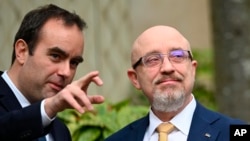Ukrainian Defense Minister Oleksii Reznikov visited Paris for talks with French leaders on Tuesday, pushing for fighter jets to help Kyiv’s fighters fend off Russia’s nearly year-long invasion.
Ukrainian officials have called on their Western allies to send the jets in order to better respond to the Russian attack, but so far those calls have been met with wariness.
When asked by reporters if France would consider sending fighter jets to Ukraine, French President Emmanuel Macron said Monday that “nothing is excluded” but laid out multiple conditions before such a step could be taken. Those included that the equipment would not touch Russian soil, would not lead to an escalation of tensions and would not “weaken the capacities of the French army.”
U.S. President Joe Biden said Monday the United States would not supply its F-16 fighter jets to Ukraine.
France, however, has agreed to ship 12 more Caesar truck-mounted howitzers and new air defense equipment to Ukraine to bolster the fight against Russia, Defense Minister Sebastien Lecornu said Tuesday in Paris. The artillery pieces add to the 18 already delivered.
The move comes with France yet to commit to sending its main Leclerc battle tanks to Ukraine, after spending weeks pressuring Berlin to supply its Leopard 2 and allow allies to re-export the German-made tanks.
Alongside other Western mobile cannons such as the German Panzerhaubitze 2000, the Caesar was credited last year with helping Ukraine strike targets deep behind Russian lines, undermining Moscow's offensive.
The truck-mounted 155mm guns can fire a highly accurate volley at ranges of up to 40 kilometers and shift position before the enemy can locate them and fire back.
Lecornu said the new batch of howitzers would be delivered "in the coming weeks" and had originally been ordered by Copenhagen. Denmark has also pledged its entire existing 19-strong fleet of the French-made howitzers to the Ukrainian war effort.
Paris will also give Kyiv a Ground Master 200 radar capable of detecting enemy aircraft at distances as far as 250 kilometers, including low-flying drones.
Ukraine won a boost last week when the United States and Germany both promised to send tanks to Ukraine, after Germany hesitated for weeks over sending its advanced Leopard 2 tanks.
Ukrainian Foreign Minister Dmytro Kuleba estimated Tuesday that a dozen countries have now promised more than 100 tanks, which he described as the "first wave of contributions."
Polish Prime Minister Mateusz Morawiecki hinted Monday at the prospect of more upcoming pledges of military support for Ukraine, saying that “any activity aimed at strengthening Ukraine’s defense powers is under consultation with our NATO partners.”
Japan, South Korea
NATO Secretary General Jens Stoltenberg stressed the wider potential effects of Russia’s invasion of Ukraine as he visited Japan on Tuesday, saying “what is happening in Europe today could happen in East Asia tomorrow.”
“If President Putin wins in Ukraine, this would send a message that authoritarian regimes can achieve their goals through brute force,” Stoltenberg told reporters at a joint news conference with Japanese Prime Minister Fumio Kishida. “Beijing is watching closely and learning lessons that may influence its future decisions.”
Stoltenberg also welcomed Japanese sanctions against Russia and “significant support for Ukraine.”
His visit to Japan came a day after he called for South Korea to send direct military support to Ukraine. The Seoul government is a growing arms exporter and has a well-equipped, U.S.-backed military.
Asked about the possibility of that support Tuesday, South Korean Defense Minister Lee Jong-sup told reporters in Seoul after meeting with U.S. Defense Secretary Lloyd Austin that “we are directing our close attention to the situation of Ukraine.”
Some information for this report came from The Associated Press, Reuters and Agence France-Presse.














